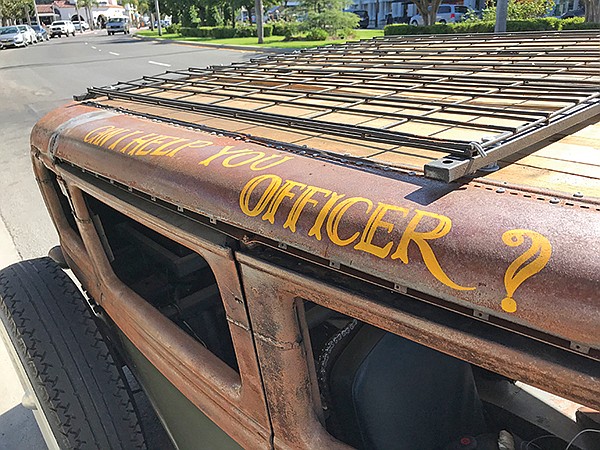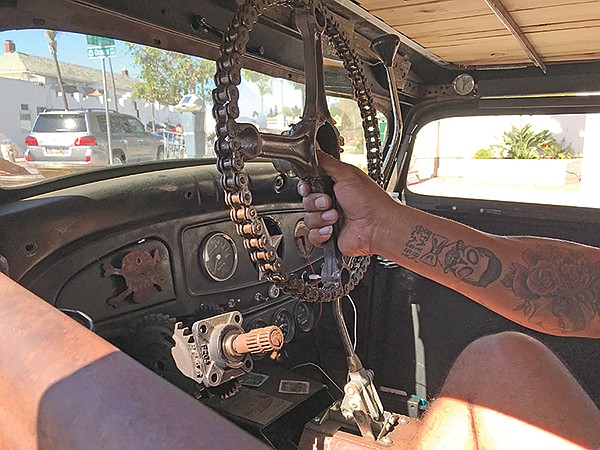 Facebook
Facebook
 X
X
 Instagram
Instagram
 TikTok
TikTok
 Youtube
Youtube

I’m like everybody else on the street. We’re bending over, craning our necks to see inside. It’s like a rusty version of every getaway car you ever saw in movies such as Bonnie and Clyde. Except it’s lower, much lower. And cooler. Wa-ay cooler.
Four huge trumpet-like exhaust pipes flare out either side, one from each cylinder. You think steam-punk. Plus large, mudguard-free wheels, low, rhino-eye headlamps, and lots of cheeky signs. “Can I Help You Officer?” says one on either side of the roof. “Rods and Broads,” says the sign on the doors. “Rosie,” says another on the back of what turns out to be a 1933 Oldsmobile Flying Cloud REO.

“Rosie? That’s her name,” says this tall, Biblically bearded guy who’s holding the steering wheel, loose, in his hand. “The engine’s a 1970 Cutlass 350, 5.7 liter.”
Olds Rocket Eighty-Eight, right? The first muscle car engine?
But by now, everybody wants a piece of the artist, Eddie Montoya. Like how did he get it so low? “Acetylene torch,” Montoya says. “Is this a hot rod?” says a kid.
“No, it’s a rat rod. You can make up your own design, and you’re supposed to drive them. Like with Rosie, only the cab and the grill are original. The 17-inch wheel rims come from an artillery Jeep. And I made a steering wheel by welding a bike chain and using piston rods as spokes.”

Montoya knows about doing structural stuff to cars, because he does it on planes. “I work on F-18 airframes for the Navy. I’ve done work with the Blue Angels.”
Unlike bona fide hot rods or restorations of old cars, Montoya says it’s not just okay, but de rigueur that your rat rod be a barely-matched collection of rusty parts from the corpses of other machines, or the remains of your original mobile. And the grease monkey retro thing continues with the rest of Montoya’s life. He plays stand-up bass in a rockabilly band, Bonneville 7. Carl Perkins classics like “Boppin’ the Blues” and “Blue Suede Shoes”, or Gene Vincent’s “Race with the Devil”. Or Hank Williams covers.
But his background is mariachi. “My birth name is Eriberto Montoya. I was brought up playing violin from age 13,” he says. In the San Fernando Valley, his church had a mariachi band. He continued mariachi through three more years in Hawaii. “But I got burned out on the violin. Then a friend just out of the service wanted to do some music. He told me his brother had an upright I could use. ‘I’ll teach you,’ he said. So that’s how I got into playing stand-up bass for Pushing Rope, an outlaw band. Like hardcore country. You’ve got to have a good ear, because stand-ups don’t have frets. You need to be on key. You have to develop muscle memory.”

Later, when I hear him actually playing with Bonneville 7, I can see how rockabilly and rat rods fit in the same muscle memory. That DIY thing applies, from his unplugged, fret-free bass-playing to the hood ornament I notice on Rosie’s radiator as he finally drives away. He made it himself, of course: a rusty, delicate 2-D reproduction of Marilyn, his upright bass.


I’m like everybody else on the street. We’re bending over, craning our necks to see inside. It’s like a rusty version of every getaway car you ever saw in movies such as Bonnie and Clyde. Except it’s lower, much lower. And cooler. Wa-ay cooler.
Four huge trumpet-like exhaust pipes flare out either side, one from each cylinder. You think steam-punk. Plus large, mudguard-free wheels, low, rhino-eye headlamps, and lots of cheeky signs. “Can I Help You Officer?” says one on either side of the roof. “Rods and Broads,” says the sign on the doors. “Rosie,” says another on the back of what turns out to be a 1933 Oldsmobile Flying Cloud REO.

“Rosie? That’s her name,” says this tall, Biblically bearded guy who’s holding the steering wheel, loose, in his hand. “The engine’s a 1970 Cutlass 350, 5.7 liter.”
Olds Rocket Eighty-Eight, right? The first muscle car engine?
But by now, everybody wants a piece of the artist, Eddie Montoya. Like how did he get it so low? “Acetylene torch,” Montoya says. “Is this a hot rod?” says a kid.
“No, it’s a rat rod. You can make up your own design, and you’re supposed to drive them. Like with Rosie, only the cab and the grill are original. The 17-inch wheel rims come from an artillery Jeep. And I made a steering wheel by welding a bike chain and using piston rods as spokes.”

Montoya knows about doing structural stuff to cars, because he does it on planes. “I work on F-18 airframes for the Navy. I’ve done work with the Blue Angels.”
Unlike bona fide hot rods or restorations of old cars, Montoya says it’s not just okay, but de rigueur that your rat rod be a barely-matched collection of rusty parts from the corpses of other machines, or the remains of your original mobile. And the grease monkey retro thing continues with the rest of Montoya’s life. He plays stand-up bass in a rockabilly band, Bonneville 7. Carl Perkins classics like “Boppin’ the Blues” and “Blue Suede Shoes”, or Gene Vincent’s “Race with the Devil”. Or Hank Williams covers.
But his background is mariachi. “My birth name is Eriberto Montoya. I was brought up playing violin from age 13,” he says. In the San Fernando Valley, his church had a mariachi band. He continued mariachi through three more years in Hawaii. “But I got burned out on the violin. Then a friend just out of the service wanted to do some music. He told me his brother had an upright I could use. ‘I’ll teach you,’ he said. So that’s how I got into playing stand-up bass for Pushing Rope, an outlaw band. Like hardcore country. You’ve got to have a good ear, because stand-ups don’t have frets. You need to be on key. You have to develop muscle memory.”

Later, when I hear him actually playing with Bonneville 7, I can see how rockabilly and rat rods fit in the same muscle memory. That DIY thing applies, from his unplugged, fret-free bass-playing to the hood ornament I notice on Rosie’s radiator as he finally drives away. He made it himself, of course: a rusty, delicate 2-D reproduction of Marilyn, his upright bass.
Comments